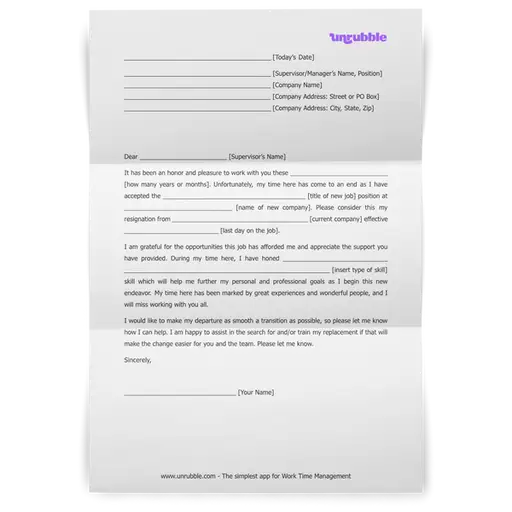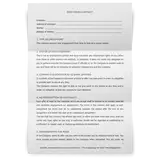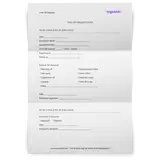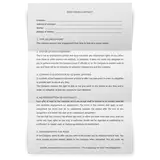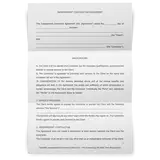Regardless of the circumstances of your departure, you should always try to leave a job gracefully, something that can be accomplished using this resignation letter template and these six tips. Former employers serve as a source of reference for future employers to know whether you produce quality work and improve the work environment. None of the work you do matters, however, if you leave poorly.
Here’s a sample Resignation Letter template that can be easily customized and adapted to meet your requirements. It’s free to download and use.
Six Ways to Resign and Leave Well
1. Give ample notice.
Unless there are safety concerns, mental or physical, the best way to ensure that you leave an employer on good terms is to give them ample notice. For some jobs, two weeks, the minimum considered a professional courtesy, should be enough time. However, in some cases, it may be prudent to give significantly more time in your notice. Typically, the greater responsibility you bear in a company, the more notice you ought to give to an employer. This is to demonstrate that their success is important to you.
One caveat to consider: if you’re leaving a post because the environment is toxic, there is a chance they may decide to end your employment immediately. Consider how they’ve treated other departures and how they’ve treated you before giving extended notice.
2. Write an excellent letter of resignation.
You want to leave an impression that is professional, kind, and honest so that your employer will only remember you well. Your letter of resignation is a perfect way to communicate praise and thanks as well as hope for your future and theirs. Don’t say things you don’t mean, but be sure to thank them for the investments they’ve made in your personal and professional development.
When using the resignation letter template, be sure to personalize it and be authentic. In the first paragraph, tell them about the job you accepted and when you’ll be leaving. Be sure to give a final day, or offer to find a final day that will work for all parties. Utilize the second paragraph to tailor to the experience you’ve had and all that you appreciate.
3. Tie up loose ends.
There is never a good time to leave, and often there are projects underway that would be hard to jump into without having been “in” at the beginning. Do your boss and the next employee a favor and tie up as many of those loose ends as time allows. Finish incomplete projects, or write great transition notes that will help the next person see them to completion.
Leave the employer and the next employee detailed notes on all that your role entails. Sometimes, even the employer may be unaware of everything that you do. Include key contacts, key deadlines, and anything you wish you’d known when you started the job. Your employer will see that as a classy move, and the person who comes behind you will be ready to succeed.
4. Offer to help in the transition.
If time allows, offer to help interview and/or train the next person in the job. If appropriate, offer suggestions of current employees who might be a good fit for the role. The employer may turn down the offer, but do not take it personally. They may want to change the role, and it would not make sense for you to help.
5. Tidy up your office.
This often goes overlooked, but do not leave your office looking trashed. Clean the desk, the keyboard, the computer screen, and empty cabinets of things that are unnecessary for the next person. Organize and clearly label files that will be important to the next employee so that they are accessible and easy to find. (This includes computer files!) Depending on how long you’ve been in the same workspace, it may be necessary to clean the walls or windows. This communicates excellence and goodwill to your now former employer.
6. Don’t be a jerk.
Perhaps your departure is not amicable, or maybe it was a lousy place to work. Whatever the reason for your leaving, do not be tempted to be a jerk in your letter of resignation or in how you decide to leave. Make them miss you by taking the high road out so that whatever already transpired, they cannot speak poorly about your departure.
Of the steps mentioned above, writing a letter of resignation may seem the most daunting. As you use this letter of resignation template, it should sound like you and be as professional but personal as possible. The best way to construct your letter is to consider what you might say in person and use those words to make it ring true. When you leave on good terms, with an excellent letter of resignation, you leave the door open to good professional relationships and great future references.
Myth busting: common misconceptions about resignation letters
Resignation letters are a crucial part of leaving a job professionally, but several misconceptions can lead to misunderstandings. Let's address and clarify five common myths related to resignation letters to enhance your understanding of this important career tool.
Myth 1: resignation letters are not necessary
Clarification: Resignation letters are essential for formally notifying your employer of your intention to leave. A resignation letter serves as an official document that clearly states your notice period and helps ensure a smooth transition. Without a formal resignation, misunderstandings can arise regarding your last working day and responsibilities during the transition.
Myth 2: any resignation letter format will do
Clarification: Using a proper resignation letter format is important for maintaining professionalism. A well crafted resignation letter should include your job title, the date of your last working day, and a brief reason for leaving if appropriate. Resignation letter templates can help ensure you cover all necessary elements and present your resignation clearly and respectfully.
Myth 3: resignation letters should be lengthy and detailed
Clarification: While it's important to be clear when you write a resignation letter with formal notice, a short resignation letter can be just as effective as a lengthy one. The key in any resignation letter example is to be concise and professional. A simple resignation letter that states your intention to resign, your last working day, and a brief expression of gratitude is often sufficient. There's no need to include excessive details or explanations.
Myth 4: resignation letters are always formal and impersonal
Clarification: While maintaining a professional tone is important, your formal resignation letter can also express gratitude and positivity. Ending on a positive note and wishing the company continued success helps leave a good impression. A thoughtful resignation letter that acknowledges the opportunities you had can strengthen your professional relationships and network.
Myth 5: resignation letters don't need to mention gratitude or transition plans
Clarification: Including expressions of gratitude and a brief mention of your commitment to a smooth transition is good practice. This shows respect for your employer and colleagues and helps ensure a positive parting. Mentioning that you are willing to assist with the transition process during your notice period can also be beneficial for both parties.
By understanding these myths and the facts behind them, you can create a more effective and professional resignation letter. Utilizing resignation letter examples and templates can help ensure your letter is well-structured and respectful, aiding in a smooth and positive transition from your current role.
